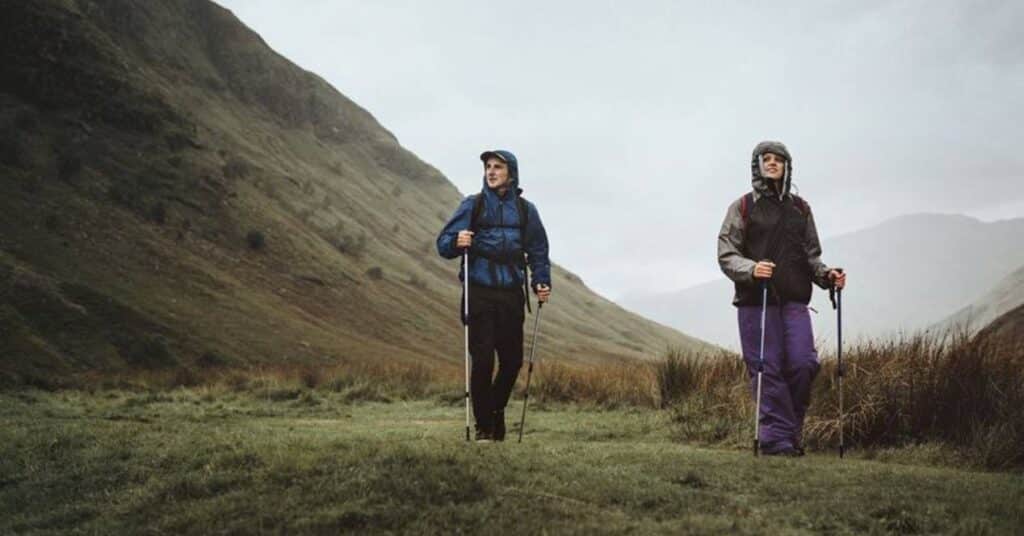
Nordic walking is a walking technique with the help of poles that burns many more calories than your usual walk. There's little to no impact to cause injury, and it can work at any intensity, from an easy walk for seniors to a fairly robust cardio workout for the already fit.
It's a good overall aerobic exercise, but with much less joint impact than running or jogging, and requires very little in the way of equipment compared to cycling or rowing. It also gets you outdoors, in parks and country trails, with many organized groups meeting up to walk and chat as they go.
What is it?
It originates from Finland and is a low-impact exercise that involves the use of special walking poles. Similar to cross-country skiing, a person uses the poles behind them as an extension of their arm to match the stride of their feet. Using these poles helps activate your upper body muscles for a full body workout.
However, it is different from walking or climbing with poles for balance and stability. During these activities, the poles are held in front of the body to improve balance.
By contrast, Nordic walking poles are held behind us, almost like an extension of the arm. With each step, we apply force to the pole to help propel the body forward faster, helping to increase the intensity of the workout without increasing the impact on the joints.
Services
The positive effects of Nordic walking are many, both for beginners and for people who have been practicing it for months.
Low impact
Nordic walking can be a good alternative to traditional forms of cardiovascular exercise for people with joint pain or arthritis. When walking, the poles help redistribute weight and can help reduce joint loading and increase muscle strength. This can help reduce pain that normally comes with prolonged, high-impact exercise, such as running.
Although some people may find the use of poles beneficial, some research argues that there is little difference between traditional walking and Nordic walking when it comes to the impact on joints.
Those with pain in their hips or knees often comment on how great Nordic Walking is for relieving lower body tension. One trial comparing the forces on joints when Nordic walking versus normal walking on level ground showed an overall reduction in shear and compressive forces at the hip and knee joints and an astonishing 28% reduction. in the shear force at the knee. Not only were the hips and knees benefited, the spine and ankles were also benefited.
Good for heart health
Nordic walking is an excellent low-impact option for those who want to improve their cardiovascular fitness. By also using the muscles of the upper body, the body requires more blood to be pumped through the heart, which requires more use of the cardiorespiratory system.
Despite this, Nordic walking seems to only slightly increase the rate of perceived exhaustion compared to traditional walking, meaning that you don't notice a huge difference in intensity even though the body is working harder.
Also, if performed at an intense enough level, it improves circulation by increasing the rate at which blood is pumped throughout the body. Even Nordic walking has additional benefits. The technique encourages active feet, full arm movement, and squeezing and opening of the hands around the pole. All of which stimulate circulation, particularly the efficient return of blood to the heart.
Full body workout
Nordic walking works the muscles of the upper and lower body, making it a great total-body exercise.
Both traditional walking and Nordic walking use the muscles of the lower body, such as the calves, hamstrings, gluteals, and quadriceps. Interestingly, Nordic walking seems to activate these muscles more effectively.
Additionally, using Nordic walking poles helps activate upper body muscles such as the latissimus dorsi, trapezius, forearm flexors, pectoralis major, deltoids, and triceps. It is also more effective for working the abdominal muscles.
Interestingly, one study found that Nordic walking does not activate the erector spinae (lower back) muscles as much as traditional walking. Therefore, for those with lower back strain, Nordic walking may be a better option.
Improve balance
Nordic walking may be a better alternative to traditional walking for older adults. A study in older adults found significant improvements in balance, functional mobility, and endurance in the Nordic walking group, while no improvements were found in the traditional walking group.
Another review of studies found that Nordic walking is more effective in improving quality of life, dynamic balance, lower body muscle strength, and aerobic capacity.
burn more calories
Nordic walking can burn up to 20% more calories than traditional walking. Compared to traditional walking, Nordic walking uses more of the upper body muscles, which requires more energy expenditure.
This is because Nordic Walking engages many more muscles than normal walking: the chest, arms, shoulders, abs, and other core muscles are involved, in addition to the legs. In addition, the poles propel us forward helping us to walk faster, raising the heart rate and expending energy.

proper technique
When it comes to technique, it all comes down to practice, but there are numerous classes all over Spain that will take you from beginner to expert in just a few sessions. Alternatively, grab some poles, turn on YouTube and you'll learn things quickly. What you should know:
- Make sure your poles are at the correct height. Start with the pole upright on the ground, your arm should be at a right angle when holding the grip.
- Adjust the loops on the pole straps so the strap isn't too tight, just snug, and the poles pivot cleanly and almost effortlessly between your thumb and fingers.
- Start walking normally, with a good upright posture, allowing your left hand to advance with your left leg, and vice versa for your right. You should feel your cane foot hit the ground with each stride as your arms swing naturally.
- Use your shoulders to push down through the pole, which should increase your stride a bit, as well as produce a little rotation through your core muscles.
- As you build speed, you'll be able to slightly exaggerate this rotation with your shoulders, making your core play more.
- As you increase your cadence, so will the calorie count and cardiovascular value of your workout.
Using the cane can be confusing at first. Even many people misuse it. The correct way to use the poles in Nordic walking are:
- Grasp a stick in each hand at a diagonal angle backwards (they should be angled so the base of the stick is behind you). The hand should lightly grasp the post.
- As we step forward with our left foot, we'll bring the right stick forward so that the base of the stick falls on the ground next to it (don't bring the stick in front of us).
- We will push the cane towards the ground behind us while taking a step with the right foot. As we fully extend our arm, we will loosen our grip so that the palm of the hand is almost completely open. This allows the arm to go through a greater range of motion and we will avoid wrist injuries.
- As this occurs, we will bring our right foot and left club forward (close the grip when the club lands to push it off the ground) and continue with the movement.
The biggest difference between traditional walking and Nordic walking is the use and positioning of the poles. We will always make sure that the poles are at an angle and are never placed in front of us.
Necessary materials
The amount of special equipment required for Nordic walking is minimal, assuming you already have a reasonable wardrobe for training outdoors. The comfortable pants for walking are ideal, as is a base layer and a windproof/waterproof jacket according to the conditions. The Socks good quality shoes are much needed, while footwear could be between trekking shoes, training shoes or light hiking boots.
The most expensive items in Nordic walking are the Canes, which have specific straps or optional glove attachments for Nordic walking, as well as a differently contoured handle compared to standard poles. Additionally, canes should have angled block-shaped rubber feet for use on hard surfaces.
Material is a big factor in the weight of poles, starting with steel (heavy, cheap), then aluminum (light, mid-range price), and finally carbon (very light, usually high-end), but don't be fooled so very cheap.
folding canes
If you're confident in the length but want better storage capacity, a 3-piece folding cane offers a good mix of packability and lightness. The Glymnis are a good example, divided into three short sections for good portability at the push of a button, but a fixed length once stowed.
See offer on AmazonTelescopic and adjustable batons
Telescopic poles stow away for easy portability, but because there are one or more adjustment points, they can vibrate more than other models. Adjustable poles have a single adjuster near the top, so they experience less vibration, but are less "portable." These are adjustable via a top motion lock, but this complexity and an alloy construction add to the weight. A nifty retractable hard tip lets you switch between hard and soft surfaces in seconds without fail.
See offer on Amazonprofessional gloves
Although Nordic walking poles usually come with detachable straps that are more than adequate for the activity, the dedicated Nordic walker can upgrade this with specific gloves. These can be either fingerless or full-fingered winter gloves, and with an additional loop between thumb and forefinger that locks onto Nordic poles. They provide maximum power transfer and comfort, as well as one less thing to worry about on the trail.
See offer on Amazon
